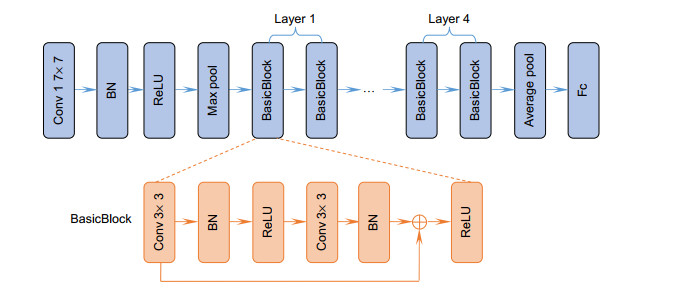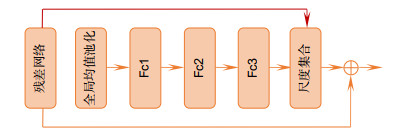Optical ship target detection method combining hierarchical search and visual residual network
-
摘要
星/机载光学遥感图像视场广阔、场景复杂,且受岸边建筑、碎云影响易产生大量与舰船目标高相似虚警,给舰船检测带来极大干扰,传统海洋舰船检测算法难以有效提取利于检测的鉴别性特征,导致舰船检测率低、虚警率高。鉴于此,本文从低虚警、低漏检角度,提出一种结合层次化搜索与视觉残差网络的光学舰船目标检测方法。首先基于纹理积分图分割出海陆区域;其次,结合多尺度局部结构特征提取目标候选区域;然后,通过基于多维度视觉特征的层次化策略进行初级虚警剔除;最后,基于视觉残差网络对疑似候选区进行精细化虚警剔除,得到最终检测结果。基于GF2光学遥感数据对本文所提算法进行测试验证,本文算法综合检测率92.0%,虚警率12.58%,平均处理时间0.5 s,检测效果好、效率高,对各种场景的适应性好,可实现复杂环境光学舰船的准确、高效检测定位。

Abstract
The star/airborne optical remote sensing image has a wide field of view and a complex scene. It is easy to produce a large number of false alarms that are similar to the ship's target due to the impact of the shore construction and broken cloud, causing great interference to the ship's detection. Traditional marine ship detection algorithms are difficult to be effective extracting discriminative features that are conducive to detection, results in low detection rates and high false alarm rates for ships. In view of this, this paper proposes an optical ship target detection method combining hierarchical search and visual residual network from the perspective of low false alarm and low missed detection. Firstly, the land and sea area are segmented based on the texture integral map; secondly, the target candidate area is extracted by combining the multi-scale local structural features; then, the primary false alarm is removed by the layered removal strategy based on multi-dimensional visual features; finally, the visual residuals are built the network finely removes false alarms from suspected candidate areas to obtain the final detection result. Based on the GF2 remote sensing GF2 set, the algorithm proposed in this paper is tested and verified. The comprehensive detection rate of this algorithm is 92.0%, the false alarm rate is 12.58%, the average processing time is 0.5 s, the detection effect is good, the efficiency is high, and the adaptability to various scenes is good. It can achieve accurate and efficient detection and positioning of optical ships in complex environments.
-
Overview

Overview: The star/airborne optical remote sensing image has a wide field of view and a complex scene. It is easy to produce a large number of false alarms that are similar to the ship's target due to the impact of the shore construction and broken cloud, causing great interference to the ship's detection. Traditional marine ship detection algorithms are difficult to be effective extracting discriminative features that are conducive to detection, results in low detection rates and high false alarm rates for ships. In view of this, this paper proposes an optical ship target detection method combining hierarchical search and visual residual network from the perspective of low false alarm and low missed detection, comprehensive utilization of advanced processing ideas of artificial intelligence. Firstly, the land and sea area is segmented based on the texture integral map; secondly, the target candidate area is extracted by combining the multi-scale local structural features; then, the primary false alarm is removed by the layered removal strategy based on multi-dimensional visual features; finally, the visual residuals are built the network finely removes false alarms from suspected candidate areas to obtain the final detection result. Based on the GF2 remote sensing GF2 set, compared with the current more typical ship inspection technology, the algorithm proposed in this paper is tested and verified. The comprehensive detection rate of this algorithm is 92.0%, the false alarm rate is 12.58%. The average processing time is 0.5 s, the detection effect is good, the efficiency is high, and the adaptability to various scenes is good. It can achieve accurate and efficient detection and positioning of optical ships in complex environments. The advantages of this technology are: 1) The land area is quickly shielded by the sea, and land segmentation technology based on the texture integral map, which improves the processing efficiency of the algorithm and effectively eliminates the interference of false land alarms; 2) Combines multi-scale local structure features to extract target candidates area, better solve the problem of low detection rate of low-quality targets; 3) Through hierarchical false alarms to propose strategies and the construction of visual residual network, gradually eliminate all types of false alarms, improve the efficiency of the algorithm. The ship target detection method proposed in this paper can be applied to the detection system of on-orbit or ground ships, and it plays an important role in the rapid and accurate detection of remote sensing moving targets. Simultaneously, the algorithm in this paper can also be applied to other rapid processing tasks of remote sensing targets. It can break through the bottleneck problem of insufficient accuracy of traditional algorithms and limited timeliness of deep learning algorithms and has a larger practical application prospect.
-

-
表 1 处理结果统计
Table 1. Statistics of processing results
场景分类 图像景数 检测舰船数量 真实舰船数量 虚警个数 检出目标总数 检测率/% 虚警率/% 处理时间/s 远洋海域 50 210 225 24 234 93.33 10.26 0.52 近岸港口 40 325 350 46 371 92.86 12.40 0.50 河道区域 30 431 475 69 500 90.74 13.80 0.48 总计 120 966 1050 139 1105 92.00 12.58 0.50 表 2 三种算法的性能对比
Table 2. Performance comparison of three algorithms
算法名称 检测率/% 虚警率/% 处理时间/s Faster-Rcnn 90.36 13.27 2.63 ssd(vgg-16) 87.24 14.35 0.95 本文算法 92.00 12.58 0.50 -
参考文献
[1] Yang F, Xu Q Z, Li B. Ship detection from optical satellite images based on saliency segmentation and structure-LBP feature[J]. IEEE Geosci Remote Sens Lett, 2017, 14(5): 602-606. doi: 10.1109/LGRS.2017.2664118
[2] 张旭. 基于模板匹配和深度学习的港口舰船检测识别方法[J]. 信息技术与信息化, 2019(4): 59-63. doi: 10.3969/j.issn.1672-9528.2019.04.017
Zhang X. A method for ship detection and recognition in port area based on template matching and deep learning[J]. Inform Technol Inform, 2019(4): 59-63. doi: 10.3969/j.issn.1672-9528.2019.04.017
[3] Xu F, Liu J H, Dong C, et al. Ship detection in optical remote sensing images based on wavelet transform and multi-level false alarm identification[J]. Remote Sens, 2017, 9(10): 985. doi: 10.3390/rs9100985
[4] 李庆峰, 何斌, 王文胜, 等. 基于谱残差和梯度纹理融合特征的舰船检测[J]. 液晶与显示, 2019, 34(8): 803-815. https://www.cnki.com.cn/Article/CJFDTOTAL-YJYS201908011.htm
Li Q F, He B, Wang W S, et al. Ship detection based on spectral residual and gradient texture fusion features[J]. Chin J Liq Cryst Display, 2019, 34(8): 803-815. https://www.cnki.com.cn/Article/CJFDTOTAL-YJYS201908011.htm
[5] Leng X G, Ji K F, Zhou S L, et al. Ship detection based on complex signal kurtosis in single-channel SAR imagery[J]. IEEE Trans Geosci Remote Sens, 2019, 57(9): 6447-6461. doi: 10.1109/TGRS.2019.2906054
[6] Gao G, Huang K H, Gao S, et al. Ship detection based on oceanic displaced phase center antenna technique in along-track interferometric SAR[J]. IEEE J Sel Top Appl Earth Obs Remote Sens, 2019, 12(3): 788-802. doi: 10.1109/JSTARS.2019.2895674
[7] 石超, 陈恩庆, 齐林. 红外视频中的舰船检测[J]. 光电工程, 2018, 45(6): 170748. doi: 10.12086/oee.2018.170748
Shi C, Chen E Q, Qi L. Ship detection from infrared video[J]. Opto-Electron Eng, 2018, 45(6): 170748. doi: 10.12086/oee.2018.170748
[8] 赵蓬辉, 孟春宁, 常胜江. 基于改进VGG网络的单阶段船舶检测算法[J]. 光电子·激光, 2019, 30(7): 719-730. https://www.cnki.com.cn/Article/CJFDTOTAL-GDZJ201907008.htm
Zhao P H, Meng C N, Chang S J. Single stage ship detection algorithm based on improved VGG network[J]. J Optoelectron Laser, 2019, 30(7): 719-730. https://www.cnki.com.cn/Article/CJFDTOTAL-GDZJ201907008.htm
[9] Wang M, Chen J Y, Wang G, et al. High resolution remote sensing image ship target detection technology based on deep learning[J]. Optoelectron Lett, 2019, 15(5): 391-395. doi: 10.1007/s11801-019-9003-7
[10] 王思明, 韩乐乐. 复杂动态背景下的运动目标检测[J]. 光电工程, 2018, 45(10): 180008. doi: 10.12086/oee.2018.180008
Wang S M, Han L L. Moving object detection under complex dynamic background[J]. Opto-Electron Eng, 2018, 45(10): 180008. doi: 10.12086/oee.2018.180008
-
访问统计


 E-mail Alert
E-mail Alert RSS
RSS

 下载:
下载:













